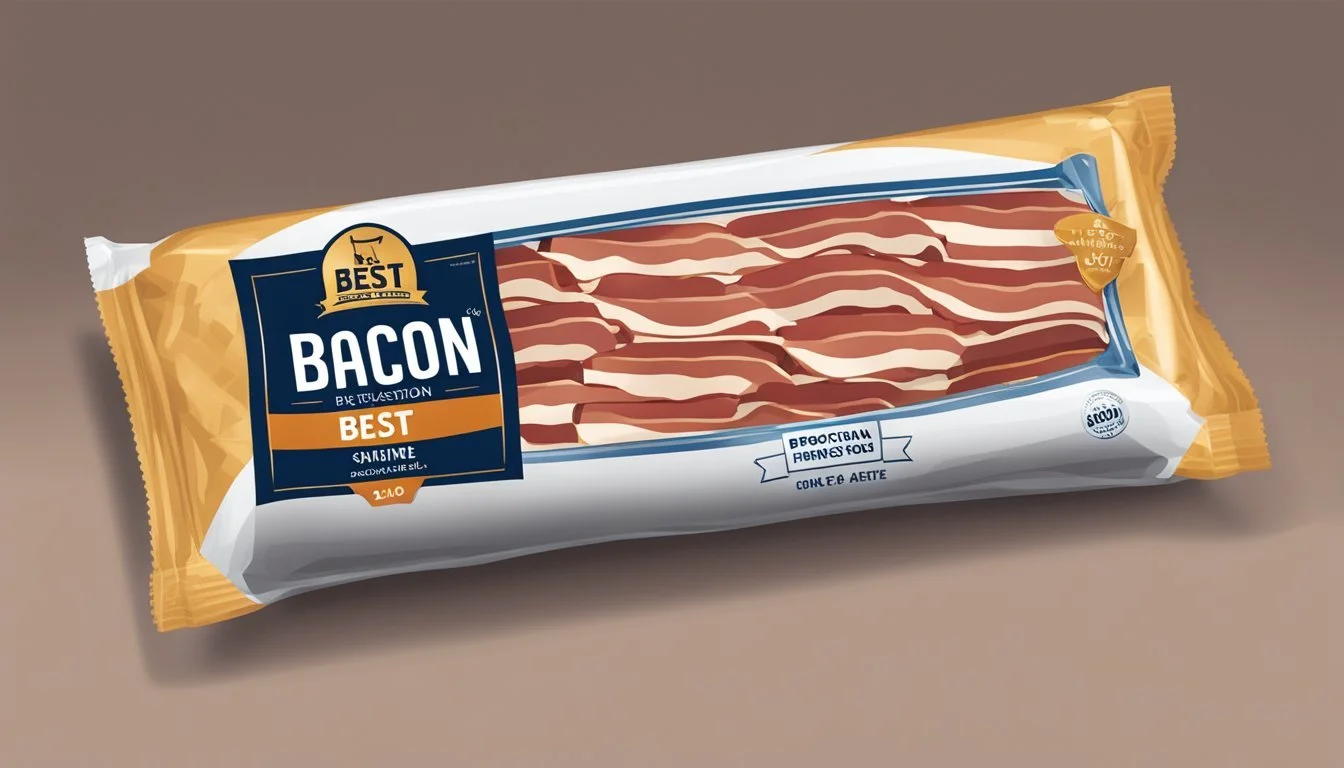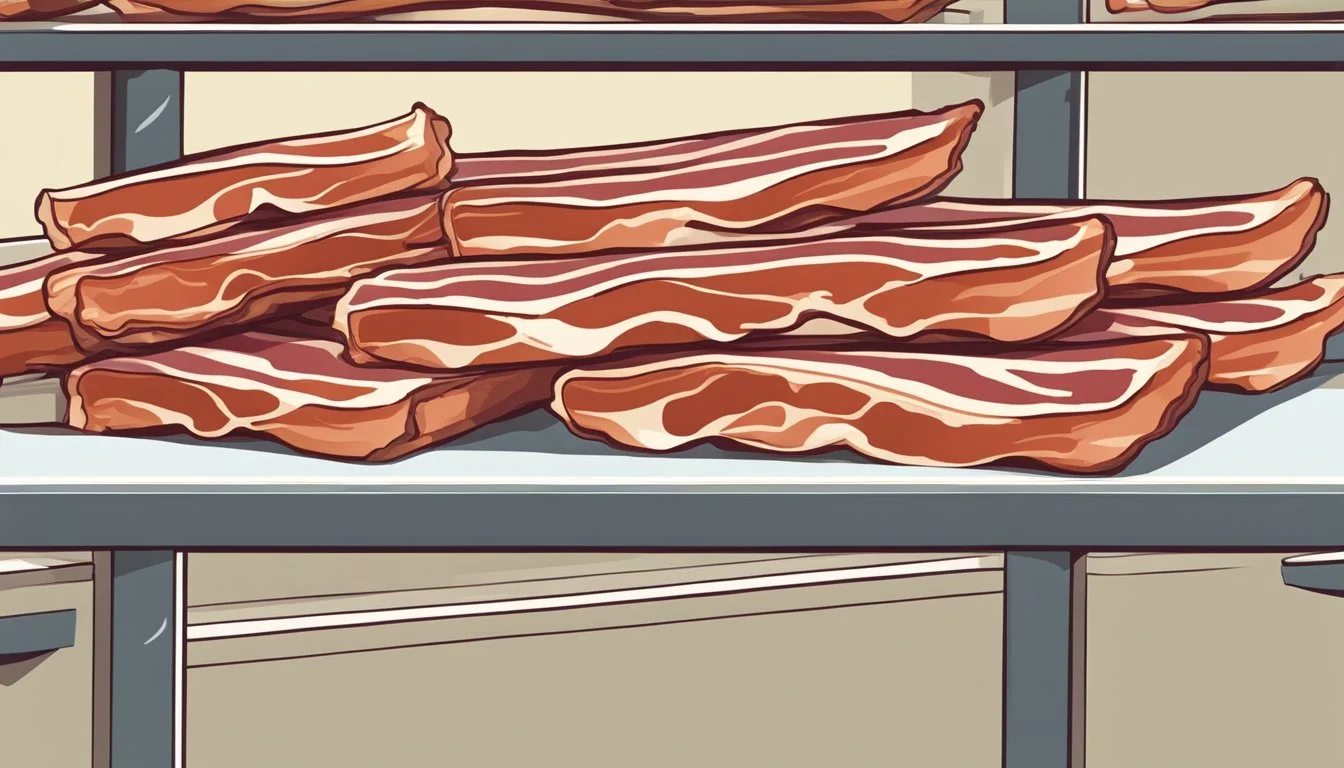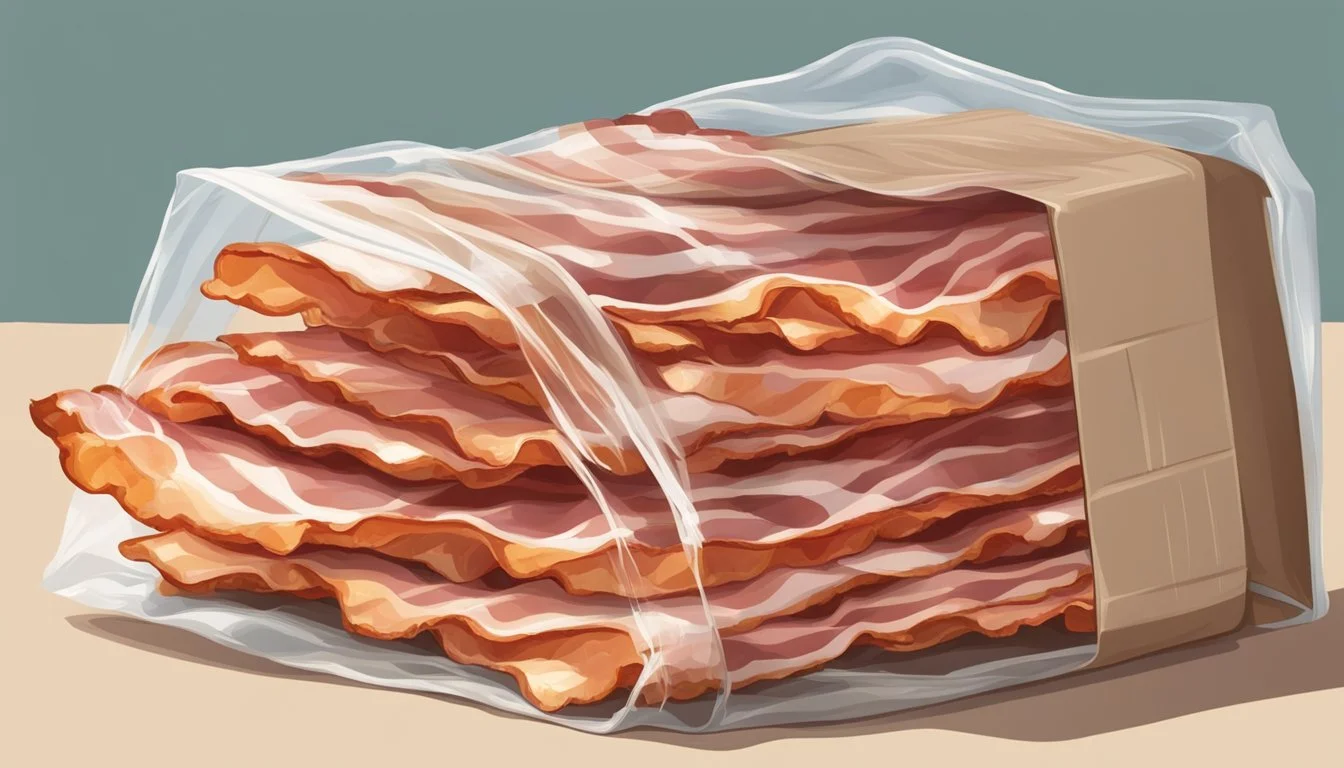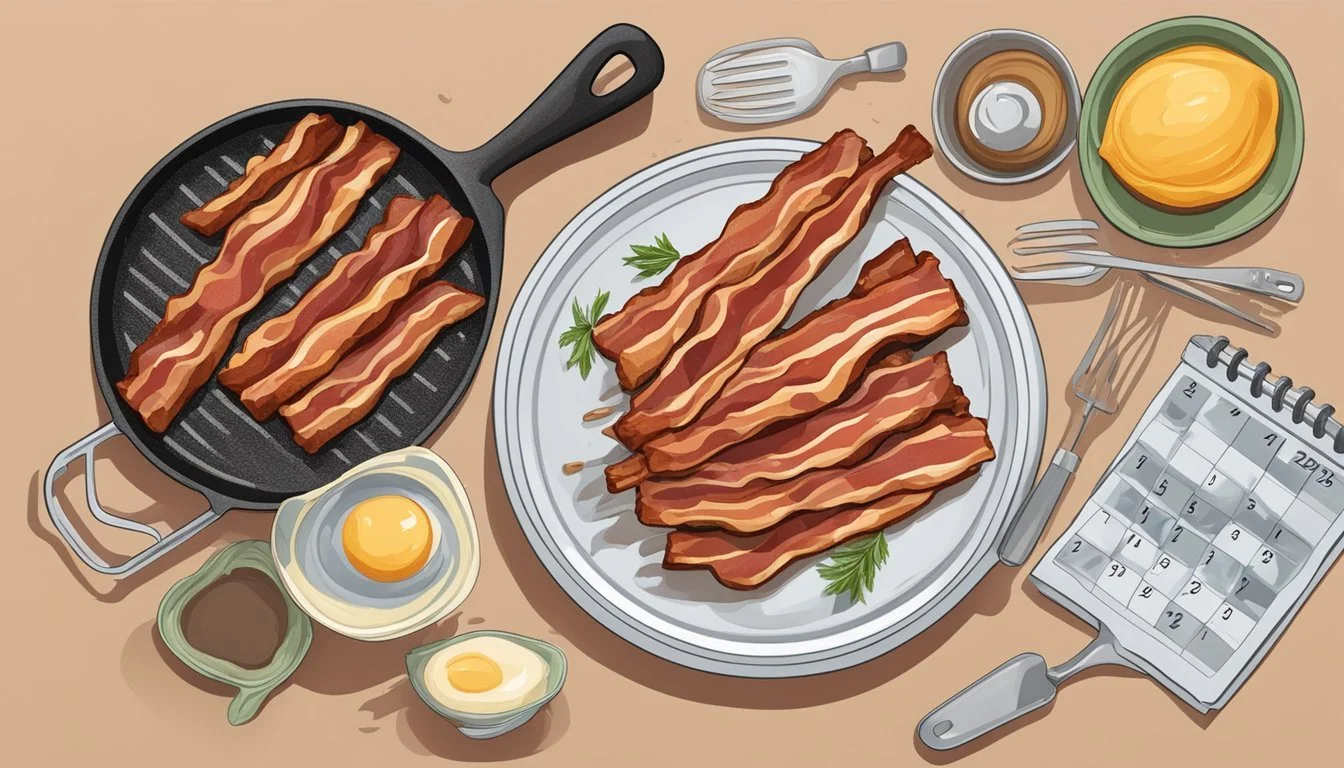How Long Does Bacon Last?
Shelf Life and Storage Insights
Bacon, a staple in many kitchens, has a varying shelf life depending on its state – whether it's raw or cooked – and the storage method. For unopened bacon stored in the refrigerator, it can last up to two weeks. The longevity of different types of bacon, such as turkey bacon or pancetta, is similar when kept in the same conditions. However, once the package is opened, the shelf life of raw bacon decreases to about one week if it's resealed and stored properly in the fridge.
When bacon is cooked, its shelf life in the refrigerator is further shortened to approximately 4-5 days. To extend the freshness of cooked or raw bacon beyond their refrigerated shelf lives, freezing is an effective option. Raw bacon can maintain its quality for 12 to 18 months in the freezer, while cooked bacon can last up to a month when frozen correctly.
It is vital to store bacon in the refrigerator or freezer immediately after purchasing it to ensure maximum freshness. Signs of spoilage include an off smell, a change in color to a duller hue, or a sticky or slimy texture. Observing these changes indicates that the bacon may have gone bad and should not be consumed.
Understanding Bacon
When discussing bacon, it's essential to consider the various types available and the packaging, which significantly impacts its shelf life and handling.
Types of Bacon
Bacon comes primarily from pork, but it also exists in other forms like turkey, beef, and alternative meats. The common types found include:
Pork Bacon: Traditional, popular in many cuisines and comes in various cuts such as regular, thick-slice, and center cut.
Turkey Bacon: A leaner, lower-fat option compared to traditional pork bacon.
Canadian Bacon: More akin to ham, it's a lean cut from the loin section of the pig.
Pancetta: An Italian variety, pancetta is pork belly (What wine goes well with pork belly?) meat that is salt-cured and spiced.
Beef Bacon: Made from beef instead of pork, it has a different flavor profile and is a favorite for those avoiding pork.
Bacon Packaging
The packaging of bacon plays a vital role in its preservation and shelf life. Here's how bacon packaging can vary:
Vacuum-Sealed Packages: For unopened bacon, reducing oxygen exposure keeps it fresher for longer.
Plastic Wrapping: Often used for opened bacon; should be tightly sealed and ideally consumed within a week.
Alongside Preservatives: Some bacon packaging includes preservatives that extend shelf life, whether opened or unopened.
Store bacon in the refrigerator or freezer, depending on how soon you plan to consume it. Always check the packaging for specific storage instructions and expiration dates to ensure quality and safety.
Storing Bacon
Proper storage of bacon is crucial for maintaining its freshness and preventing spoilage. The methods vary depending on whether the bacon is unopened or opened, and whether it's being stored in the refrigerator or freezer.
Unopened Bacon Storage
Unopened bacon should be stored in its original packaging in the refrigerator. The unopened package can be placed in the coldest part of the fridge, usually the back, to maintain a steady temperature. Unopened bacon typically remains fresh for up to two weeks in the refrigerator, provided that the fridge maintains a consistent temperature of 40°F (4°C) or below.
Opened Bacon Storage
Once the bacon package is opened, any remaining bacon should be stored in the refrigerator and tightly wrapped. It can be wrapped in aluminum foil or plastic wrap, or placed in an airtight container to prevent contamination and the absorption of other food odors. Opened bacon should be consumed within one week; if it emits a sour odor or develops a slimy texture before this time, it should be discarded.
Freezing Bacon
Bacon can be frozen to extend its shelf life. To freeze bacon, one should wrap it in aluminum foil or plastic wrap, then place it in an airtight container or a freezer bag to minimize exposure to air. Unopened bacon can last in the freezer for up to eight months while opened bacon is recommended to be used within six months. To thaw bacon, it's best to leave it in the refrigerator overnight; never thaw bacon on the countertop as this can lead to bacterial growth.
Bacon Shelf Life
The shelf life of bacon varies depending on whether it is unopened, opened, or cooked. Proper storage is essential to prevent spoilage and ensure safety.
Shelf Life of Unopened Bacon
Unopened bacon typically lasts up to two weeks in the refrigerator. If the bacon is not going to be used within this timeframe, storing it in the freezer can considerably extend its shelf life, allowing it to remain fresh for about six to eight months.
Shelf Life of Opened Bacon
Once opened, the shelf life of raw bacon decreases. In the refrigerator, opened bacon should be consumed within one week. For longer storage, placing the opened bacon in the freezer can help maintain its quality for up to six months.
Shelf Life of Cooked Bacon
Cooked bacon has a shorter shelf life compared to its raw counterparts. In the refrigerator, it can last for about four to five days. When properly stored in the freezer, the shelf life of cooked bacon extends up to one month. Cooked bacon should be stored in an airtight container or tightly wrapped to maximize freshness.
Identifying Spoilage
Knowing how to identify spoiled bacon is crucial to ensure food safety. This section will explore visual, olfactory, and textural indicators to accurately assess the quality of bacon.
Visual Indicators
Color: Fresh bacon displays a natural pink or red hue with white or yellowish fat. Discoloration can signal spoilage; if bacon appears green, grey, or brown, it may be bad.
Appearance: Look for any signs of mold, which might present as fuzzy or spotted patches on the bacon's surface.
Olfactory Indicators
Odor: Healthy bacon will have a fresh, meaty smell with a hint of smokiness. Spoiled bacon often emits a sour or unpleasant odor, akin to the smell of rotting meat.
Textural Indicators
Texture: Bacon should feel fresh and moist but not wet or slimy. If the bacon is sticky, slimy, or has an abnormal tacky texture, it is a clear indicator of bacterial growth and spoilage.
Safety and Health Considerations
When it comes to bacon, safety and health are paramount. Consumers must be vigilant in preventing food poisoning and understanding the risks associated with consuming spoiled bacon.
Preventing Food Poisoning
Proper handling and cooking of bacon are crucial to prevent food poisoning. Bacon should be cooked until it reaches a safe internal temperature which kills pathogens such as Salmonella and Trichinosis.
Storing: Uncooked bacon should be kept in the refrigerator at 40°F (4°C) or below and used within one week of opening.
Cooking: Reach an internal temperature of 145°F (63°C) followed by a three-minute rest period before consumption.
Refrigerating Leftovers: Cooked bacon should be refrigerated within two hours of cooking and consumed within four to five days.
Risks of Spoiled Bacon
Eating spoiled bacon can lead to serious health issues. The presence of bacteria can cause gastrointestinal illnesses, while the consumption of rancid fat can impact one's overall health. Indicators that bacon has spoiled include:
Off-putting Smell: A sour or unusual odor is a clear sign the bacon has gone bad.
Discoloration: Spoiled bacon may exhibit greenish, gray, or brown colors.
Texture: If the bacon is slimy or sticky, it may be contaminated with harmful bacteria.
Maximizing Bacon Freshness
The shelf life of bacon can be extended through meticulous storage and preservation practices. These methods ensure optimal freshness, quality, and flavor are maintained.
Proper Storage Techniques
When storing bacon, whether it's raw or cooked, using a sealed container is crucial to preserving its freshness. For raw bacon, the initial packaging provides a good seal, but once opened, it should be transferred to a glass container or wrapped in wax paper and then placed in a resealable bag to prevent moisture and contaminants.
Unopened Raw Bacon: Store in the fridge, in its original vacuum-sealed packaging, until the sell-by date or use-by date.
Opened Raw Bacon:
Wrap with wax paper or paper towels to absorb excess moisture.
Seal in a container or zip-top bag.
Use within one week of opening.
For cooked bacon:
Cool to room temperature.
Line a sealed container with paper towels to absorb grease.
Separate layers with paper towels to prevent stickiness.
Store away from raw meats to prevent cross-contamination.
Consume within 4 to 5 days.
Using Preservatives
Preservatives can help in extending the shelf life of bacon, ensuring the maintenance of flavor and quality. However, the addition of chemical preservatives at home is not commonly practiced or recommended. Instead, relying on proper cooking, cooling, and storing techniques is often more appropriate for individuals. Commercial bacon frequently includes preservatives like sodium nitrate to maintain freshness and color; consumers can look for these details on packaging labels.
Bacon in Cuisine
Bacon's flavor profile and versatility make it a quintessential component in various classic dishes while also serving as a complementary element to pair with other foods.
Classic Bacon Dishes
BLT Sandwich: A staple in American cuisine, the BLT combines bacon, lettuce, and tomato between slices of bread — often toasted and sometimes augmented with mayonnaise. The dish hinges on the savory crunch of the cooked bacon.
Breakfast Platter: In this cornerstone morning dish, bacon frequently accompanies eggs and coffee, with its salty, crispy texture providing a counterbalance to the creaminess of the eggs and the bitterness of the coffee.
Pairing Bacon with Other Foods
In salads: Bacon's crispiness adds texture to leafy greens while its fat content enhances flavor. Leftover bacon can be crumbled as an addition to salads.
With seafood: Bacon wraps around seafood such as shrimp or scallops (What wine goes well with scallops?), infusing them with a smokey depth.
In baking: Bacon can be included in pastries or savory scones, offering unexpected bursts of flavor.
Bacon Grease: It's used for sautéing or frying, lending a smoky depth to dishes. As for storage longevity, bacon grease can last up to 6 months when properly stored in a cool, dark place.
Bacon End-of-Life
Proper disposal of spoiled bacon is crucial to maintain hygiene and prevent the spread of foodborne illness. Spoilage is often detectable through senses and should be taken seriously for food safety.
Disposing of Spoiled Bacon
When bacon has spoiled, it exhibits noticeable changes in color, texture, and scent. An individual can typically rely on their senses to determine spoilage. If the bacon has a sour smell, slimy texture, or off color, it should be disposed of immediately.
To dispose of spoiled bacon, one should place the bacon in a sealable bag to contain the odor and prevent leakage. The wrapped bacon can then be discarded in the trash. It's important not to pour bacon grease down the sink as it can solidify and clog plumbing. Instead, it should be cooled and thrown away with the solid waste.
Regularly clearing out expired food items from the refrigerator, including bacon, contributes to a hygienic kitchen environment and reduces the risk of cross-contamination.








